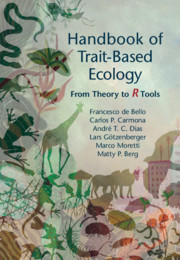Book contents
- Handbook of Trait-Based Ecology
- Handbook of Trait-Based Ecology
- Copyright page
- Epigraph
- Contents
- Preface
- 1 General Introduction
- 2 Trait Selection and Standardization
- 3 The Ecology of Differences
- 4 Response Traits and the Filtering Metaphor
- 5 Community Metrics
- 6 Intraspecific Trait Variability
- 7 Community Assembly Rules
- 8 Traits and Phylogenies
- 9 Effects of Traits on Ecosystem Processes and Services
- 10 Response and Effect Traits across Trophic Levels
- 11 Trait Sampling Strategies
- 12 Applied Trait-Based Ecology
- References
- Index
11 - Trait Sampling Strategies
Published online by Cambridge University Press: 08 March 2021
- Handbook of Trait-Based Ecology
- Handbook of Trait-Based Ecology
- Copyright page
- Epigraph
- Contents
- Preface
- 1 General Introduction
- 2 Trait Selection and Standardization
- 3 The Ecology of Differences
- 4 Response Traits and the Filtering Metaphor
- 5 Community Metrics
- 6 Intraspecific Trait Variability
- 7 Community Assembly Rules
- 8 Traits and Phylogenies
- 9 Effects of Traits on Ecosystem Processes and Services
- 10 Response and Effect Traits across Trophic Levels
- 11 Trait Sampling Strategies
- 12 Applied Trait-Based Ecology
- References
- Index
Summary
Chapter 11 illustrates different strategies to obtain reliable and robust trait data from both field sampling and experiments. An exercise is provided to familiarize readers with different alternatives for sampling traits, and their implications for sampling effort, providing advice on defining a realistic trait sampling campaign. Examples show that a feasible sampling strategy needs to sacrifice aspects of trait variability of lower importance for the ecological questions being asked and how researchers should attempt to compromise between the most accurate and most precise estimations of trait values. Special attention is given to the expected effect of species turnover vs intraspecific trait variability adjustments across gradients, depending on the extent of the studied environmental gradient. The choice of a given sampling scheme is framed into simple trade-offs between two extreme cases: sampling several individuals for each species from only a single population, or sampling one individual per species in each population in which the species occur along a gradient. A flowchart guide for choosing among different sampling combinations along this trade-off is provided.
Information
- Type
- Chapter
- Information
- Handbook of Trait-Based EcologyFrom Theory to R Tools, pp. 210 - 230Publisher: Cambridge University PressPrint publication year: 2021
Accessibility standard: Unknown
Why this information is here
This section outlines the accessibility features of this content - including support for screen readers, full keyboard navigation and high-contrast display options. This may not be relevant for you.Accessibility Information
- 1
- Cited by
